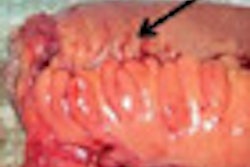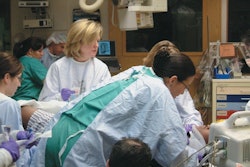Tracheomalacia, a weakness in the tracheal walls and supporting cartilage that can cause expiratory collapse, can be difficult to diagnose. Dual-phase CT provides a fast and accurate means of diagnosing the condition, but its use comes with an important caveat: double the radiation dose.
Tracheomalacia symptoms can be mistaken for chronic asthma or prolonged bronchiolitis, and the traditional diagnostic workup for the condition calls for not just one but two CT scans. Radiologists at Children's Hospital Boston have been able to reduce radiation dose for this procedure by 23%, a significant reduction because the majority of pediatric patients suspected of having either congenital or acquired tracheomalacia are younger than 2 years.
Starting in August 2007, radiologists at Children's Hospital Boston implemented a reduced-dose protocol that decreased CT tube current by 50% for the expiratory phase of the procedure, in conjunction with "child-sizing" radiation doses based on a patient's age and weight. The quality of the images using this technique has not compromised diagnostic confidence since the protocol was implemented.
To determine if undertaking initiatives to further reduce radiation dose would be appropriate, pediatric radiologist Dr. Edward Y. Lee and colleagues conducted a retrospective study formally evaluating the diagnostic accuracy of standard-dose and reduced-dose dual-phase CT imaging. Their findings were published in the April issue of Academic Radiology (2010, Vol. 17:4, pp. 504-510).
Two groups of 20 demographically matched patients were randomly selected among those who received a dual-phase CT exam between December 2004 and April 2009 for clinically suspected tracheomalacia. The patients ranged in age from 1 month to 15 years (median age, 7 months) for the standard-dose group, and from 2 weeks to 12 years (median age, 14 months) for the reduced-dose group.
Both a 16-detector-row scanner (LightSpeed 16, GE Healthcare, Chalfont St. Giles, U.K.) and a 64-detector-row scanner (Somatom Sensation 64, Siemens Healthcare, Malvern, PA) were used to acquire images with the standard-dose protocol, whereas the 64-detector-row scanner was used exclusively to acquire images with the reduced-dose protocol.
The protocol for both groups consisted of imaging at the end-inspiration phase and the end-expiration phase. For 35 children who required general anesthesia and intubation, these phases of MDCT scanning were performed by alternatively applying and withholding positive pressure ventilation respectively during inspiration and expiration.
Automated tube-current modulation was used on both scanners, with the reference tube current selected based on the patient's weight for the 16-detector-row scanner and the patient's age for the 64-detector-row scanner. The average effective radiation dose for each sequence using the standard-dose technique was 3.1 ± 2.2 mSv. With the reduced-dose technique, the average effective radiation dose of the inspiratory phase was 3.2 ± 1.3 mSv and 1.6 ± 0.6 mSv for the end-expiratory phase.
Two experienced pediatric radiologists blinded to the technical parameters of the CT scans reviewed the images by consensus to assess for evidence of tracheal collapse and to select a confidence level rank for each exam. Accurate diagnoses and confidence level ranks proved to be comparable for each group.
"Our results highlight the fact that the inherently high contrast between the air-filled tracheal lumen and adjacent soft-tissue attenuation of the mediastinum allows for considerable CT dose reduction while maintaining the ability to confidently measure the tracheal lumen," the authors noted. They suggested that even more than a 23% dose reduction may be achievable and recommended further investigation.
By Cynthia E. Keen
AuntMinnie.com staff writer
April 20, 2010
Related Reading
GE completes first pediatric dose reduction install, June 18, 2009
Color-coded CT protocols help reduce pediatric radiation dose, June 4, 2009
SPR news: Rads must take lead in reducing pediatric CT dose, April 23, 2009
ARRS study: Child's body shape can reduce CT dose, April 23, 2009
Study: Radiologists dial back on pediatric CT settings, October 4, 2008
Copyright © 2010 AuntMinnie.com



















